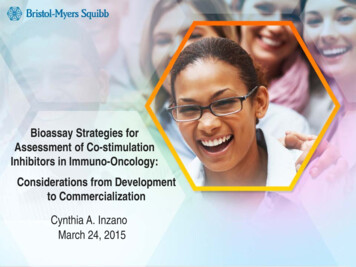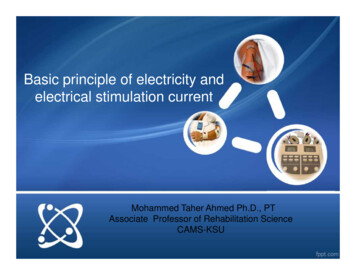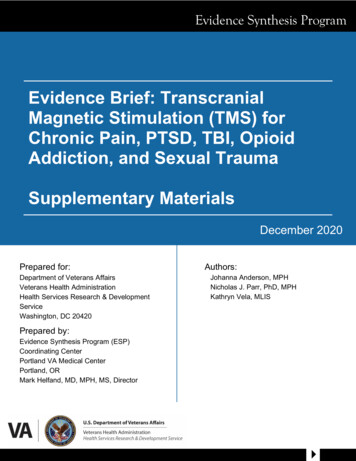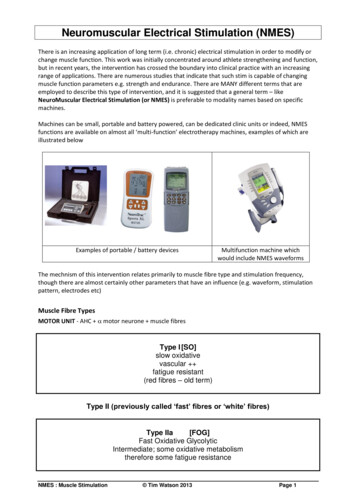
Transcription
Bioassay Strategies forAssessment of Co-stimulationInhibitors in Immuno-Oncology:Considerations from Developmentto CommercializationCynthia A. InzanoMarch 24, 2015
OutlineBackground of Immunomodulatory AntibodiesTargeting Checkpoint proteinsInhibitory pathwayImmunomodulatory AntibodiesBioassay Development and ComplexitiesConsiderations in Bioassay DevelopmentExample BioassaySummary
BackgroundImmune System and Tumors– Immune response to tumors involves: Foreign protein or antigenAntigen Presenting Cell (APC) recognition and processingAPC present via Major Histocompatibility Complex (MHC) to T-cellT-cell receptor recognition and activationCo-Stimulation requiredBalance of T-cell regulation through inhibitory and co-stimulatorypathways– Tumor mechanism for immune resistance: Dysregulation of immune checkpoints of effector cells:– T-cell and NK cell– Immunomodulatory antibodies Agonist/antagonist activitiesJaneway & Travers, Immunobiology, 1994.
Approaches to Immunotherapy in Immuno-OncologyMechanisms of Immunomodulation1. Immunomodulatory Cancer Autoimmunity2. Properties Bi-functional– F(ab) domain– Fc domain – therapeutic function Target effector functions FcγRs (ADCC and ADCP) Inhibitory/Co-stimulatory pathways of gy/reference-technology-monoclonal-antibodies
Inhibitory and Co-Stimulatory CheckpointsTargeting immunecheckpoints– Target effector cells: T- cellsstimulatory and inhibitorypathways– Modulate agonist andantagonist response– T-cell activation requires costimulatory interactionAmin, A. (2013). High-dose interleukin-2:is it still indicated for melanoma and RCC in an era of targetedtherapies? Retrieved from n import/2150177.png
Inhibitory PathwayInhibitory Signaling– Block CD3/CD28 mediatedactivation– Results in decreased Proliferation Cytokine production MigrationStrategies BioassayDevelopment– Understand MOA– Cell LineChristopher J. Nirschl, and Charles G. Drake Clin Cancer Res 2013;19:4917-4924
Examples of Targets in Immuno-OncologyD. Berman et al. / Pharmacology & Therapeutics 148 (2015) 132–153Approved Opdivo (Nivolumab), Yervoy (Ipilimumab), Nulojix (Belatacept), Orencia (Abatacept)PipelineUrelumab (anti-CD137), Lirilumab (Anti-KIR), Lulizumab (Anti-CD28), BMS-9860616 (Anti-LAG3), BMS-936559 (Anti-PD-L1),BMS-936561 (CD70), BMS-986178 (anti-OX-40)
Bioassay Development ComplexitiesComplex Signaling System– Multiple Receptors involved CD3 /anti-CD3 (primary) CD28 /CD80/86 (co-stimulatory) PD-1/PDL-1 (inhibitory)Mechanism of Action– In Vitro– In VivoMultiple Cellular Events– Proliferation– Cytokine production– Migration
Immunomodulatory AntibodiesYervoy (Ipilimumab) Mechanism
Immunomodulatory AntibodiesOpdivo (Nivolumab) Mechanism
Bioassay Development ConsiderationsCell Line Selection– Single or Multiple Transfection BeadsExample Signaling Pathway– PI3K /AktExample Readouts– Cytokine– ReporterELISA AbsorbanceLuciferase Chemiluminescence
Example DevelopmentCell based Bioassay using a cytokine ELISA Kit– Day 1 Bioassay Cell prep, antibody dilution, incubation– Day 2 ELISAEvaluation of Bioassay– Characterization of cell lines (one or two)– Components in Bioassay– Components in ELISAPoints to Consider in Development– Cell Passage– Cell Bank Quality– Serum
Considerations for Pre-Commercial:CellPassageConsiderations for– Identification of Cell line(s)– Characterization and Trending Passage Receptor level overtime (flow cytometry) Doubling time Performance in the bioassayPercent Viability of Two different Cell Lines over passagingSignal-to-NoiseConsistencyover passagingReceptor Densityin Flow 10.040000S/NViabilityAntibodies per cell (ABC) Viability% Viability Cells Line 1Quality% ViabilityCell ControlLine 2200005.094.00.0 092.0121234445676788101310129Passage10 Number11Passage12 Number13 14Passage Number141516161617 181819 201922
Considerations for Pre-Commercial:Cell BankDeveloped In-House or Purchased––––CostSpeedTechnical expertiseControl/ExperienceSingle use vials or Continuous Culture–––––Cost to ProduceManufacturing capacityQC friendlyPassaging hands-on-timeCell Changes over time
Considerations for Pre-Commercial: SerumPoints to Consider––––Vendor to Vendor DifferencesLot to Lot VariationComponents within SerumSerum treatments Heat treated/no-heat treatment Gamma irradiated– Serum alternativesQualification– Passaging– Trending– System tm
Considerations for Pre-Commercial:Serum Vendor Differences Shape of Curve– Lower Asymptote/Upper Asymptote, Slope, EC50
Considerations for Pre-Commercial:Serum Lot Differences Shape of Curve– Lower Asymptote/Upper Asymptote, Slope, EC50
Considerations for Pre-Commercial:Serum Treatment Shape of Curve– Upper Asymptote, Slope, EC50
Example of Bioassay Accuracy fromImmuno-Oncology
Example of Bioassay Linearity fromImmuno-OncologyLinearity : Theoretical vs. Measured PotencyN 6180Measured % Potency160140120100806040200020y 0.9645x 2.0017R² 0.9958406080100Theoretical % Potency120140160180
Control Trending of Commercial Bioassay inImmuno-Oncology
SummaryImmunomodulatory Antibodies– Complex co-stimulatory systemsBioassay Development– Impact of Particular Components Cell Passaging Cell Banking SerumExploring co-stimulatory systems– Relation to other mechanisms of action ADCC
AcknowledgmentsBristol-Myers Squibb– Molecular and Analytical Development Marisol PalmieriVanessa FearonXuefeng LiRyman NavoaChristine VanAukenJessie YinColleen QuinnLeeAnn Benson-IngrahamRuojia LiLei XieJeffery GlennMarcel ZocherReb Russell
Janeway & Travers, Immunobiology, 1994. Immune System and Tumors - Immune response to tumors involves: Foreign protein or antigen Antigen Presenting Cell (APC) recognition and processing APC present via Major Histocompatibility Complex (MHC) to T-cell T-cell receptor recognition and activation Co-Stimulation required










